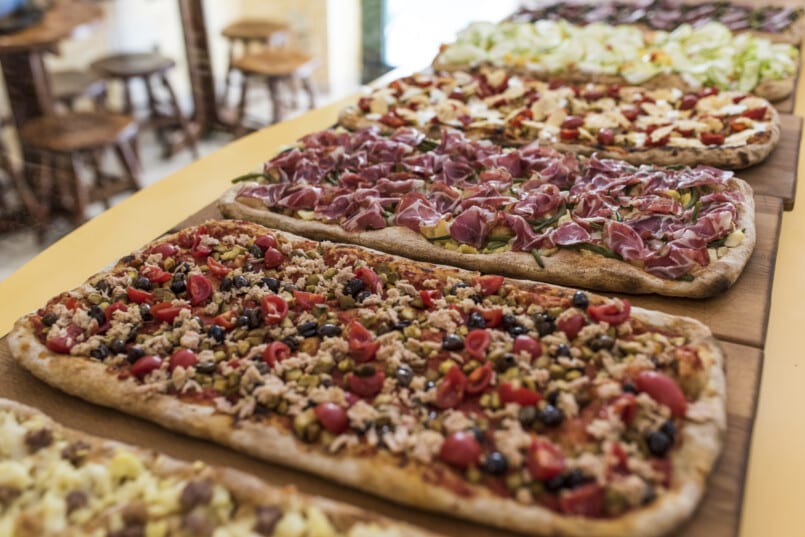Traveling on a shoestring doesn’t have to mean bland meals or skipped dinners. If you know where to look for cheap food in Europe, you can eat well for surprisingly little. I spent seven days crossing a few classic cities and kept my food budget to about $40. No starving, no instant noodles. Just smart choices, local markets, bakery counters, and street dishes that locals actually buy. This guide shows exactly what I ate, how much I spent, and the little moves that make Europe’s cheap food realistic. If you want a practical blueprint for eating well without draining your budget, this is how I did it—and how you can too.
Ground Rules That Made It Work
Before the day-by-day, a few guidelines shaped the plan. They’re the mindset behind cheap food in Europe:
- Eat where commuters eat; not where the selfie sticks gather.
- Buy breakfast at bakeries and snacks at supermarkets.
- Use lunch specials and set menus; they’re a goldmine for Europe’s cheap food.
- Carry a bottle to refill water, and keep salt, pepper, and a folding spork in your daypack.
- Walk five minutes off the main square; prices drop fast.
I kept a soft cap of €6 per day and tracked everything. Total spend for the week: €36.20—about $40 at the exchange rate I had.
Day 1 — Paris: The €5.40 Warm-Up
Paris has a reputation, but it’s also where I first proved that Europe’s cheap food is about timing and location. I grabbed a bakery “formule” near a commuter station: one croissant and a small coffee for €1.60. It wasn’t fancy; it was fresh and fast.
Midday, I stopped at a neighborhood market. A baguette piece, a tomato, and a small wedge of budget brie cost €2.10. I made an open-face sandwich on a park bench.
Dinner came from a mom-and-pop traiteur offering a daily box: ratatouille over rice for €1.70. Warm, filling, and proof that cheap food in Europe often hides behind steam-fogged glass.
Day total: €5.40

Day 2 — Amsterdam: Market Lunches and Pocket Snacks
Amsterdam’s markets are built for cheap food in Europe. At Albert Cuyp, I tried a herring roll for €2.30. It sounds intense; it’s great protein and keeps you full.
For a snack, I bought a cone of fries with mayo for €2.00. Split it with a friend and it’s practically a side.
Dinner was stamppot from a family canteen that feeds locals on their commute: €1.50 for a small bowl. Add a grocery-store apple (€0.40) and you’re set.
Want more tricks like these? See budget-first playbooks in the Travel Hacks section at Viral Voyage they’re built around finding Europe’s cheap food without guesswork.
Day total: €5.80
Day 3 — Berlin: Supermarket Masterclass
Berlin is where supermarkets make cheap food in Europe feel easy. I bought a day kit at Lidl: half a loaf of bread, 4 slices of ham, 4 slices of cheese, a cucumber, and yogurt. Total €3.90.
Breakfast was bread and yogurt. Lunch: two ham-and-cheese sandwiches with cucumber. Dinner: open-faces with the rest of the cheese and veg. I also grabbed a bakery pretzel for €0.70 to keep energy up while walking the city.
No, it’s not Michelin. It’s fueling your day, and it’s the smartest path to Europe’s cheap food when you want to stretch your cash for museums or trains.
Day total: €4.60
Day 4 — Prague: Bowls, Dumplings, and Comfort
Prague might be the poster child for Europe’s cheap food. I started with a café special: filter coffee and a small honey cake slice for €1.30.
Lunch was garlic soup with bread for €1.80. It was cold outside; the soup made everything better.
Dinner: roast pork with dumplings and cabbage at a no-frills pub for €1.70. Portions here can be hefty, so pace yourself. Prague proves that comfort food and cheap food in Europe are not opposites.
Day total: €4.80
Day 5 — Budapest: Hearty Plates on a Tiny Budget
Budapest might be the most generous stop for cheap food in all of Europe. Breakfast was a warm, savory langos to share for €1.20.
Lunch was classic goulash soup—paprika-rich, beefy, and satisfying—for €1.80.
Dinner: chicken paprikash with nokedli for €1.70. The flavors were bold, the room smelled like cooked peppers and butter, and my budget barely noticed. If you’re building a long trip around cheap food in Europe, make a line for Budapest.
Day total: €4.70
Day 6 — Rome: Slices and Set-Menu Pasta
Pizza al taglio is the Roman key to cheap food in Europe. Breakfast was an espresso and cornetto for €2.00 total.
Lunch: a thick, blistered slice of margherita for €2.50. I ate it on the steps of a quiet piazza and felt very lucky.
Dinner: a worker’s menu from a neighborhood pasta shop—half portion of carbonara with bread and tap water—for €1.40. Rome rewards anyone who wanders two blocks off a postcard-perfect street. You’ll find Europe’s cheap food there; you just have to step away from the English-language menu.
Day total: €5.90

Day 7 — Lisbon: Seafood, Soup, and Custard
Lisbon is the gentle landing for a week of cheap food in all of Europe. Breakfast was a pastel de nata and a short coffee for €1.50.
Lunch: grilled sardines on bread at a small tasca for €2.50.
Dinner: caldo verde for €0.90 and a small plate of bacalhau à brás for €0.60—ordered as “meia dose” and absolutely enough. Lisbon closes the loop: oceanside flavors without oceanside prices, which is what Europe’s cheap food is all about.
Day total: €5.00
The Math: €36.20 For the Week
- Paris: €5.40
- Amsterdam: €5.80
- Berlin: €4.60
- Prague: €4.80
- Budapest: €4.70
- Rome: €5.90
- Lisbon: €5.00
Total: €36.20—about $40 when I exchanged. I didn’t count spices or the folding spork because I already had them, but even if you buy those once, your next weeks get cheaper. Track your own totals and you’ll see how repeatable cheap food in all of Europe becomes.
Snacks That Save the Day
Snacks are the secret backbone of cheap food in Europe. They bridge the gap between late lunches and long walks.
- Bakery pretzels in Germany or Austria: salty, filling, under €1.
- Bananas or apples from supermarkets: calorie-dense, travel well.
- Yogurt cups in Central Europe: cheap protein and probiotics.
- Sunflower seeds or peanuts: small bag, big mileage.
Buy them where locals buy them, and they’ll keep Europe’s cheap food on track even on long sightseeing days.
Micro-Strategies I Used Daily
1) The bakery window test. If there’s a commuter rush and a laminated “formule” or “menu” card, you’re about to find cheap food in entire Europe that locals trust.
2) The three-block rule. Walk three blocks from the main square and check prices again. That’s where Europe’s cheap food turns from theory to reality.
3) Lunch > dinner. Many cities offer a discounted midday set; make lunch your big meal and you’ll still keep cheap food in all of Europe standards high.
4) Grocery anchors. Bread, fruit, yogurt become your anchors. Layer local treats on top and you still maintain Europe’s cheap food spending.
5) Water refills. Bring a bottle; it’s free, and skipping paid drinks is a big reason cheap food in Europe works.
For destination ideas to pair with this eating style, the Epic Destinations collection at Viral Voyage is a great scouting map.
Where to Buy Without Overthinking
- Supermarkets: Lidl, Aldi, Penny, Biedronka, Continente. These chains are the backbone of Europe’s cheap food.
- Markets: Look for weekday morning markets near transit stops; vendors price for locals rushing to work.
- Canteens and worker cafés: Fewer frills; more value. Lunch sets make cheap food in Europe both filling and affordable.
- Tascas, pubs, trattorie off-center: If there’s a hand-written board and no picture menu, you’ve likely found Europe’s cheap food.
If you travel while working, this routine slots neatly into a remote-work rhythm. The Digital Nomad section at Viral Voyage has city guides that align with budget eating and good Wi-Fi.
City-by-City Cheat Sheet for Cheap Bites
Paris: Bakery “formules,” couscous shops, Vietnamese banh mi. All reliable lanes to cheap food in Europe.
Amsterdam: Markets for herring and fries; Indonesian snacks by weight at neighborhood delis.
Berlin: Döner kebab and supermarket spreads; a master class in Europe’s cheap food.
Prague: Soup and dumplings; filling calories for coins.
Budapest: Langos, goulash, paprika-rich mains; comfort-food heaven for Europe’s cheap food travelers.
Rome: Pizza al taglio, supplì, and worker lunches.
Lisbon: Pastel de nata, grilled sardines, caldo verde; coastal flavor at budget prices.
Mistakes That Blow the Budget
- Dining next to landmarks. Two streets over is where Europe’s cheap food lives.
- Buying drinks with every meal. Water is the quiet champion of cheap food in Europe.
- Skipping supermarkets altogether. Even one quick shop per day anchors cheap food in Europe spending.
- Assuming “cheap = low quality.” Some of the best meals I had were under €3, and that’s the heart of cheap food in Europe.
Packing Tiny Tools That Pay Off
- Folding spork: Lets you split portions and eat on the go.
- Mini spice vial: A pinch of chili or pepper upgrades simple supermarket meals.
- Zip bag: Keep leftover bread or fruit for later.
- Lightweight bottle: Refill and cut drink costs; the unsung hero of cheap food in Europe.
These little items make Europe’s cheap food less about sacrifice and more about flexibility.
How I Chose Portions and Timing
I aimed for three mini-meals and one snack, with the largest calories midday. That schedule fits walking days and museum afternoons. It also harmonizes with the way cheap food in Europe is sold: bakeries early, hot canteens at lunch, takeaway sets before close. If I craved dessert, I paired it with a long walk; gelato in Rome or a custard tart in Lisbon tastes better when it’s “earned.”
What This Teaches About Travel Style
Spending less on meals didn’t mean seeing less. It meant seeing more. Chasing cheap food in Europe pushed me into neighborhoods I might have skipped, where I chatted with bakers, watched office workers queue, and learned what busy locals eat. That’s cultural immersion you can’t buy in a central square. The map in my head now is built from the smell of bread at 7 a.m., the clang of soup bowls at noon, and the sizzle of sardines at dusk.
If you love stretching your budget across more days and more cities, browse the On a Budget library for route ideas that sync perfectly with cheap food in Europe habits —then connect the dots with the rest of Viral Voyage’s guides as you plan.

The $40 Week: Why It Worked
In the end, Europe’s cheap food comes down to three behaviors: shop like a local, eat with the workday crowd, and treat lunch as your main event. Every city I visited had a clear lane for budget eaters; I just had to step into it. My totals prove it’s repeatable: €36.20 for seven days of warm bread, soup, pizza, dumplings, grilled fish, and street snacks. Not once did I feel like I was settling. I felt connected; I felt full; I felt free to spend on the experiences I came for. Try this template, tweak it to your taste, and watch how quickly Europe’s cheap food becomes your favorite travel habit.
Travel farther on less—unlock more cheap food in Europe tricks and itineraries on Viral Voyage.



